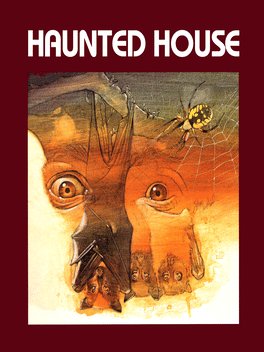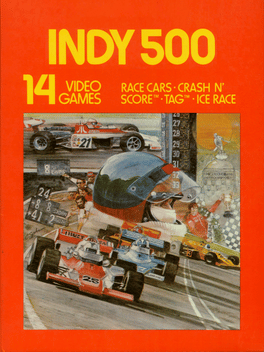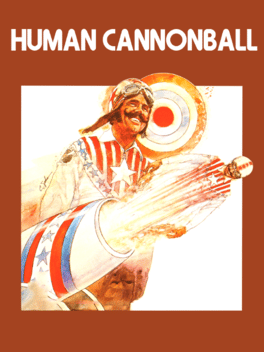Most Popular Atari 2600 Games
-
E.T. the Extra-Terrestrial
1982
star 4.8E.T. the Extra-Terrestrial (also referred to simply as E.T.) is a 1982 adventure video game developed and published by Atari, Inc. for the Atari 2600 video game console. It is based on the film of the same name, and was designed by Howard Scott Warshaw. The objective of the game is to guide the eponymous character through various screens to collect three pieces of an interplanetary telephone that will allow him to contact his home planet. It is widely regarded as the worst game ever made and one of the major contributing factors to the near death of the video game industry in 1983. -
Adventure
1980
Adventure
1980
star 7.6Adventure is a video game for the Atari 2600 video game console, released in 1980. In the game, the player controls a square avatar whose quest is to hunt an open world environment for a magical chalice, returning it to the golden castle. The game world is populated by roaming enemies: dragons, which can eat the avatar; and a bat, which randomly steals and hides items around the game world. Adventure was designed and programmed by Atari employee Warren Robinett, and published by Atari, Inc. At the time, Atari programmers were generally given full control on the creative direction and development cycle for their games, and this required them to plan for their next game as they neared completion of their current one to stay productive. Robinett submitted the source code for Adventure to Atari management in June 1979 and soon left Atari. Atari released the game in early 1980. -
Combat
1977
Combat
1977
star 6.9Combat is an early video game by Atari, Inc. for the Atari 2600. It was based on two earlier black-and-white coin-operated arcade games produced by Atari. Combat had color graphics and numerous gameplay variations. The 27 game modes featured a variety of different combat scenarios, including tanks, biplanes, and jet fighters. The tank games had interesting options such as bouncing munitions ("Tank-Pong") and invisibility. The biplane and jet games also allowed for variation, such as multiple planes per player and an inventive game with a squadron of planes versus one giant bomber. -
Pac-Man
1982
Pac-Man
1982
star 7.9Atari 2600 Port of Pac-Man The player controls Pac-Man through a maze, eating pac-dots (also called pellets). When all pac-dots are eaten, Pac-Man is taken to the next stage. Between some stages one of three intermission animations plays. Four enemies (Blinky, Pinky, Inky and Clyde) roam the maze, trying to catch Pac-Man. If an enemy touches Pac-Man, a life is lost and the Pac-Man itself withers and dies. When all lives have been lost, the game ends. Pac-Man is awarded a single bonus life at 10,000 points by default. Near the corners of the maze are four larger, flashing dots known as power pellets that provide Pac-Man with the temporary ability to eat the enemies. The enemies turn deep blue, reverse direction and usually move more slowly. When an enemy is eaten, its eyes remain and return to the center box where it is regenerated in its normal color. Blue enemies flash white to signal that they are about to become dangerous again and the length of time for which the enemies remain vulnerable varies from one stage -
Superman
1979
Superman
1979
star 3Superman is an action adventure game for the Atari 2600. It was one of the first single-player games for the system and one of the earliest licensed video games. Superman is one of the first to utilize multiple screens as playing areas. -
Boxing
1980
Boxing
1980
star 6.9Boxing is an action boxing game for one or two players which is played from an overhead point of view. The game lasts for two minutes, and the player who can earn the most points in that time wins. You earn one point for a long jab, two points for a close power punch, and if you can manage knockout it's worth one hundred points. Two difficulty levels are included which can be set individually for each player. -
Alien
1982
Alien
1982
star 7.3Fox Video Games made the first leap into licensing the Alien property for video games with what was essentially a Pac-Man clone skinned with elements from the 1979 film. Players controlled a human collecting Alien eggs (dots) and small planet and spaceship symbols (fruits) in a maze abroad the USCSS Nostromo while avoiding Alien drones (ghosts). Drones could be killed by shooting them with a flamethrower or collecting symbols that would stun them (flashing dots). -
Haunted House
1982
Haunted House
1982
star 7Haunted House is an Atari 2600 video game written by James Andreasen and published by Atari, Inc. in February 1982. The player, represented by a pair of eyes, must navigate the haunted mansion of the late Zachary Graves to recover the three pieces of an urn. The game has been identified as one of the earliest examples of the survival horror genre. -
Dodge 'Em
1980
Dodge 'Em
1980
star 5Dodge 'Em is a 1980 Atari 2600 video game, a driving game based on Sega's Head On (1979). The player controls one car and has to drive counter-clockwise, avoiding computer-controlled cars whose sole aim is to produce a head-on collision. The player's car can travel at two speeds, a 'normal' speed which is the same speed as computer-controlled cars, or if the player presses the controller button, his or her car travels at a 'fast' speed double its normal speed. The computer-controlled cars have only one speed. Players change lanes by pushing the controller in the appropriate direction when their car is near one of the gaps in the roadway. -
Space War
1978
Space War
1978
star 4.7This video game is an Atari 2600 port of Spacewar!, the famous 1962 computer game by Steve Russell. The cartridge comes programmed with 17 game variations. Variations 1 to 13 are duels between two ships and 14 to 17 are for one player. In some of the variations the ships fight near a planet which has gravitational attraction. This concept was used in the Star Control series of games. -
Indy 500
1977
Indy 500
1977
star 5Indy 500 is a 1977 racing video game developed by Atari, Inc. for its Video Computer System (later known as the Atari 2600). It is themed around the Indianapolis 500, and is based on Atari's earlier 8-player arcade game, Indy 800. Indy 500 was one of the nine launch titles offered when the Atari 2600 went on sale in September 1977. Sears Tele-Games later re-released it as Race; no changes were made to the gameplay. Included with each game was a set of two driving controllers, which were identical in appearance to the 2600 paddle controller but could rotate indefinitely in either direction, among other differences. -
Street Racer
1977
Street Racer
1977
star 4.6Street Racer is an action racing game for one to four players played from an overhead view. The screen is split into two lanes; in one or two player games, each player has a lane. In three and four player games, players must share the lanes. Each game has a two minute and sixteen second time limit, and your goal is to earn as many points as possible by the end of this time. In addition to the basic racing version, several other game variations are included as well. -
Frostbite
1983
Frostbite
1983
star 6.2You're an Eskimo who wants to build an igloo to live in during the cold season. To do this, you must jump from ice-block to ice-block, while avoiding wildlife such as birds and crabs. Coming with contact with any of these will cause them to push you off the block and into the deadly water. Once you have built your igloo, you must enter it to proceed to the next level. Remember, you must build it before the temperature drops to 0°. You have four lives. -
Human Cannonball
1978
Human Cannonball
1978
star 3.7In Human Cannonball your goal is to fire a man out of a cannon and have him land in a bucket of water. To do this you need to adjust your cannon so the position, angle, and firing speed are just right. You score a point for each successful landing, and the game ends after seven attempts. Several game variations are included which allow you to have the position, angle and speed all set by the player, or have one or more of these in a fixed position, or have one or more of these randomly set by the computer. If you wish to make the game more challenging, you can also set a moving wall in front of the bucket which will make your timing more critical. -
Missile Command
1981
-
Video Olympics
1977
Video Olympics
1977
star 5.2Video Olympics a collection of games from Atari's popular arcade Pong series is one of the nine 2600 launch titles. The games are a collection of "bat and ball" style games, including several previously released by Atari as coin-ops in the early 1970s. The games are played using the 2600s paddle controllers and are for one to four players (three or four players requires a second set of paddle controllers). Each of the 10 main games have several variations to count the total of 50 games. -
Seaquest
1983
Seaquest
1983
star 7.2Your divers have collected treasure from the ocean floor. On their way back up to surface they are attacked by hostile fish, sharks and enemy submarines. It is, therefore, your task to collect your divers with your own submarine. While doing that you are not totally defenceless since your sub is able to fire bullets. But you have to watch out for your oxygen level which is shown at the bottom of the screen - once it is depleted, you die. So, every now and then you have to surface to replenish your oxygen supply. But you will lose one of the rescued divers if you surface with less than six frogmen onboard. After having rescued six divers, you move on to the next stage. As the game progresses, the then enemies become faster and more numerous. -
Star Ship
1977
Star Ship
1977
star 3.9Star Ship is a First-person shooter video game cartridge developed by Atari, Inc. for its Video Computer System (later known as the Atari 2600). The game was one of the nine launch titles offered when the Atari 2600 went on sale. It was designed and programmed by Bob Whitehead. It was based on the Atari arcade game Starship 1. The re-branded Sears TeleGames version was titled "Outer Space". -
Fishing Derby
1980
Fishing Derby
1980
star 6.9In Fishing Derby, two fishermen sit on opposite docks over a lake filled with fish (and a shark that passes through). Using the joystick the player is able to move his line left right and up and down in the water. When a fish is hooked, the line slowly comes up to the surface of the water. Pressing the fire button on the joystick reels in the fish faster. However, if both fishermen have fish hooked, only one person can reel theirs in (the one who hooked theirs first). The shark that roams the water will try to eat hooked fish before they surface. The objective for both fishermen is to reach 99 pounds of fish first. There are six rows of fish; the top two rows have 2 lb. fish, the middle two rows have 4 lb. fish, and the two bottom rows have 6 lb. fish. The more valuable fish sit at the bottom, but they are harder to bring in as they run a higher risk of being eaten by the shark. The game's two variants are simply single player and multi-player. In both games the objective is to reach 99 lb. of fish first. -
Grand Prix
1982
Grand Prix
1982
star 6The player drives a Formula One car in a time trial on one of four race tracks, each of which has a different difficulty level. Difficulty is gauged by the length of the course, the number of cars and oil slicks on the track, and the number of bridges to cross. The player views the race from a top-down perspective, and the screen scrolls from right to left. The player's car maneuvers only on a vertical axis, and loses a little speed when it does so. The joystick's button is the throttle: Depressing it accelerates, and releasing it decelerates. Pressing the joystick leftward applies the brake. The transmission audibly shifts as the player's car accelerates and decelerates. Grand Prix is a time trial, and the competing cars are obstacles rather than competition for the finish line. The player's car can easily outpace the other cars, but if it collides with one, its speed drops lower than that of the impacted car. Driving over an oil slick causes the player's car to skid slightly sideways, but does not slow it down. O



















